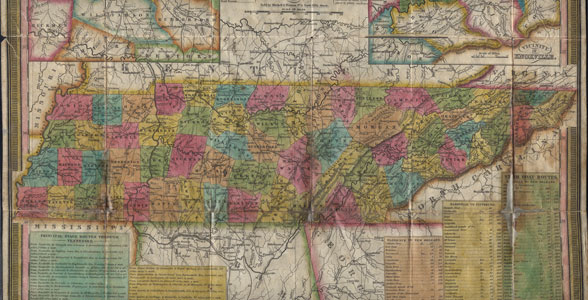

Even before Tennessee became a state, cartographers began mapping the region, noting the native American settlements, rivers, and mountains. Later maps offer a window on the state’s growth, showing the development of counties and major transportation routes.
The Special Collections department of the UT Knoxville Libraries has an extensive historic map collection that concentrates on Tennessee and contiguous states. Tennessee Alumnus shows you a sampling here. The map collection is available for viewing. For information, e-mail special@utk.edu or call 865-974-4480.

This 1762 map of Cherokee Country includes Fort Loudon and “Enemy Mountains.” The map was the work of Henry Timberlake, a cartographer from Virginia. During the time Timberlake spent with the Cherokee, he befriended several chiefs. At lower left is a list of chiefs’ names and “the number of fighting men they send to war.”

Names of towns and rivers are included on the 1760 map of the Cherokee Nation, thought to have been produced in London. The areas shown are in Southeast Tennessee, North Carolina, and Georgia.

A map of Tennessee Government, issued in 1794, two years before Tennessee became a state, includes Knoxville and Nashville and details the region’s waterways. The map was produced for Carey’s American edition of Guthrie’s Geography.

4) This 1814 map shows many towns for the first time.

5) Insets of Nashville and Knoxville highlight this 1850 map by Thomas, Cowperthwait & Co. Distances from place to place along stage and steam boat routes are shown.

6) This Civil War–era map from Harper’s Weekly (February 22, 1862) shows the theater of war in West Tennessee.

7) Engraved by Young and Delleker, this 1831 map shows Tennessee’s counties much as they exist today. In Southeast Tennessee, note the area that had been returned to the Cherokee Indians from Monroe and McMinn counties.